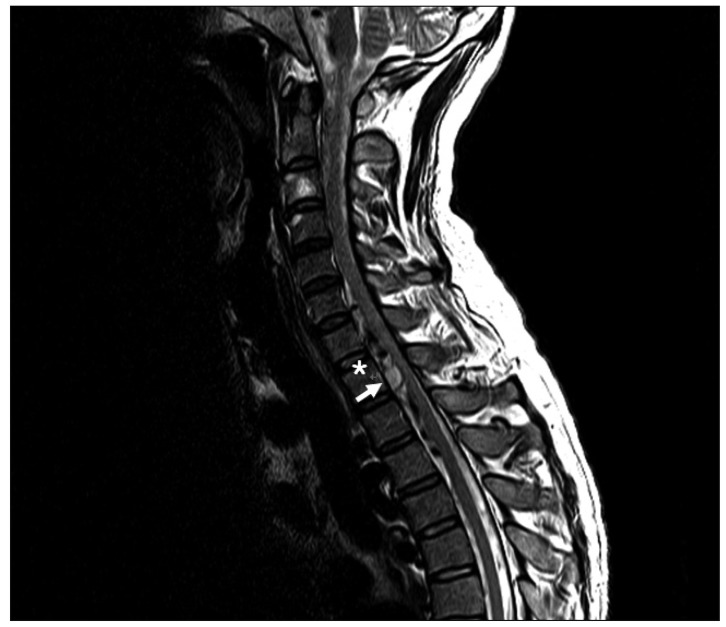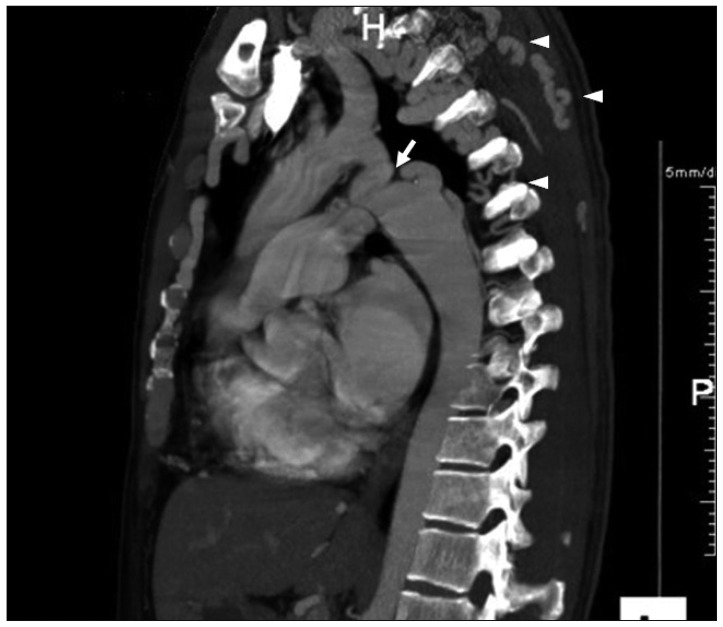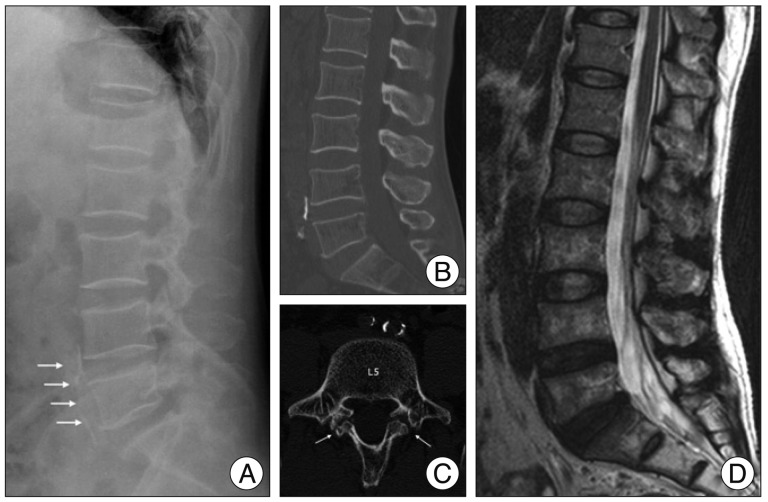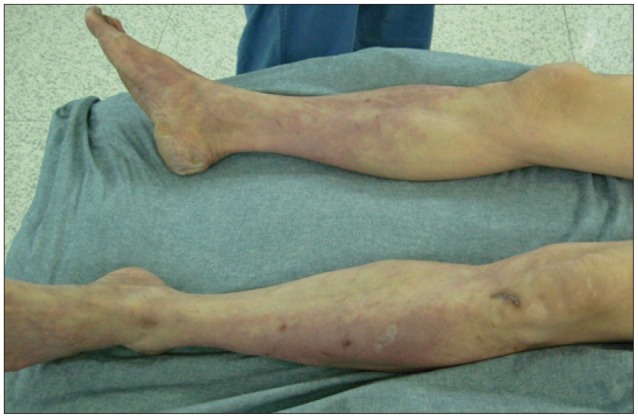J Korean Neurosurg Soc.
2014 Mar;55(3):156-159. 10.3340/jkns.2014.55.3.156.
Paraplegia due to Acute Aortic Coarctation and Occlusion
- Affiliations
-
- 1Department of Internal Medicine, Kyung Hee University Hospital at Gangdong, Kyung Hee University School of Medicine, Seoul, Korea.
- 2Department of Neurosurgery, Kyung Hee University Hospital at Gangdong, Kyung Hee University School of Medicine, Seoul, Korea. apuzzo@hanmail.net
- 3Department of Neurosurgery, Kyung Hee University Hospital, Kyung Hee University School of Medicine, Seoul, Korea.
- 4Department of General Surgery, Kyung Hee University Hospital at Gangdong, Kyung Hee University School of Medicine, Seoul, Korea.
- KMID: 2191082
- DOI: http://doi.org/10.3340/jkns.2014.55.3.156
Abstract
- Coarctation and occlusion of the aorta is a rare condition that typically presents with hypertension or cardiac failure. However, neuropathy or myelopathy may be the presenting features of the condition when an intraspinal subarachnoid hemorrhage has compressed the spinal cord causing ischemia. We report two cases of middle-aged males who developed acute non-traumatic paraplegia. Undiagnosed congenital abnormalities, such as aortic coarctation and occlusion, should be considered for patients presenting with nontraumatic paraplegia in the absence of other identifiable causes. Our cases suggest that spinal cord ischemia resulting from acute spinal subarachnoid hemorrhage and can cause paraplegia, and that clinicians must carefully examine patients presenting with nontraumatic paraplegia because misdiagnosis can delay initiation of the appropriate treatment.
MeSH Terms
Figure
Reference
-
1. Aktas C, Cinar O, Ay D, Gürses B, Hasmanoglu H. Acute aortic dissection with painless paraplegia : report of 2 cases. Am J Emerg Med. 2008; 26:631.e3–631.e5. PMID: 18534306.2. Banna MM, Rose PG, Pearce GW. Coarctation of the aorta as a cause of spinal subarachnoid hemorrhage. Case report. J Neurosurg. 1973; 39:761–763. PMID: 4759663.3. Blaisdell FW, Steele M, Allen RE. Management of acute lower extremity arterial ischemia due to embolism and thrombosis. Surgery. 1978; 84:822–834. PMID: 715701.4. Campbell M. Natural history of coarctation of the aorta. Br Heart J. 1970; 32:633–640. PMID: 5470045.
Article5. Domenicucci M, Ramieri A, Paolini S, Russo N, Occhiogrosso G, Di Biasi C, et al. Spinal subarachnoid hematomas : our experience and literature review. Acta Neurochir (Wein). 2005; 147:741–750. discussion 750. PMID: 15711890.6. Edwards KC, Katzen BT. Superior mesenteric artery syndrome due to large dissecting abdominal aortic aneurysm. Am J Gastroenterol. 1984; 79:72–74. PMID: 6691326.7. Godart F. Intravascular stenting for the treatment of coarctation of the aorta in adolescent and adult patients. Arch Cardiovasc Dis. 2011; 104:627–635. PMID: 22152515.
Article8. Hino H, Maruyama H, Inomata H. A case of spinal artery aneurysm presenting transverse myelopathy associated with coarctation of the aorta. Rinsho Shinkeigaku. 1989; 29:1009–1012. PMID: 2689031.9. Hölper P, Hyhlik-Dürr A, Kotelis D, von Tengg-Kobligk H, Böckler D. Paraplegia after spontaneous dissection of the abdominal aorta. Vasa. 2009; 38:254–258. PMID: 19736638.
Article10. Inamasu J, Hori S, Yokoyama M, Funabiki T, Aoki K, Aikawa N. Paraplegia caused by painless acute aortic dissection. Spinal Cord. 2000; 38:702–704. PMID: 11114779.
Article11. Karacostas D, Anthomelides G, Ioannides P, Psaroulis K, Psaroulis D. Acute paraplegia in painless aortic dissection. Rich imaging with poor outcome. Spinal Cord. 2010; 48:87–89. PMID: 19528998.
Article12. Kelley CE. Nontraumatic abdominal aortic thrombosis presenting with anterior spinal artery syndrome and pulmonary edema. J Emerg Med. 1991; 9:233–237. PMID: 1861056.
Article13. Kochar G, Kotler MN, Hartman J, Goldberg SE, Parry W, Parameswaran R, et al. Thrombosed aorta resulting in spinal cord ischemia and paraplegia in ischemic cardiomyopathy. Am Heart J. 1987; 113:1510–1513. PMID: 3591620.
Article14. Lins E, Vlajic I, Wappenschmidt J. Spinal subarachnoid hemorrhage in a case of stenosis of the aorta (author's transl). Rontgenblatter. 1977; 30:239–244. PMID: 866925.15. Lusby RJ, Wylie EJ. Acute lower limb ischemia : pathogenesis and management. World J Surg. 1983; 7:340–386. PMID: 6880224.16. Nandeesh BN, Mahadevan A, Santosh V, Yasha TC, Shankar SK. Acute aortic dissection presenting as painful paraplegia. Clin Neurol Neurosurg. 2007; 109:531–534. PMID: 17475398.
Article17. O'Dell KB, Hakim SN. Dissecting thoracic aortic aneurysm in a 22-year-old man. Ann Emerg Med. 1990; 19:316–318. PMID: 2310071.18. Poirée S, Monnier-Cholley L, Tubiana JM, Arrivé L. Acute abdominal aortic thrombosis in cancer patients. Abdom Imaging. 2004; 29:511–513. PMID: 15024514.
Article19. Surowiec SM, Isiklar H, Sreeram S, Weiss VJ, Lumsden AB. Acute occlusion of the abdominal aorta. Am J Surg. 1998; 176:193–197. PMID: 9737631.
Article20. Swan L, Wilson N, Houston AB, Doig W, Pollock JC, Hillis WS. The long-term management of the patient with an aortic coarctation repair. Eur Heart J. 1998; 19:382–386. PMID: 9568441.
Article21. Triantafyllopoulos GK, Athanassacopoulos M, Maltezos C, Pneumaticos SG. Acute infrarenal aortic thrombosis presenting with flaccid paraplegia. Spine (Phila Pa 1976). 2011; 36:e1042–e1045. PMID: 21289558.
Article
- Full Text Links
- Actions
-
Cited
- CITED
-
- Close
- Share
- Similar articles
-
- Paraplegia with Rapid Deterioration in a Thrombocytopenic Patient: A Case Report of Acute Aortic Thrombosis
- Fatal Aortic Tumor Embolism Presenting as Acute Paraplegia
- Coarctation of the Aorta Associated with Chronic Thoracic Aortic Aneurysm: A case report
- Intraabdominal Aortic Obstruction with Severe Low Back Pain and Acute Paraplegia: Case Report
- Coarctation of the aorta associated with thoracic aortic aneurysm






